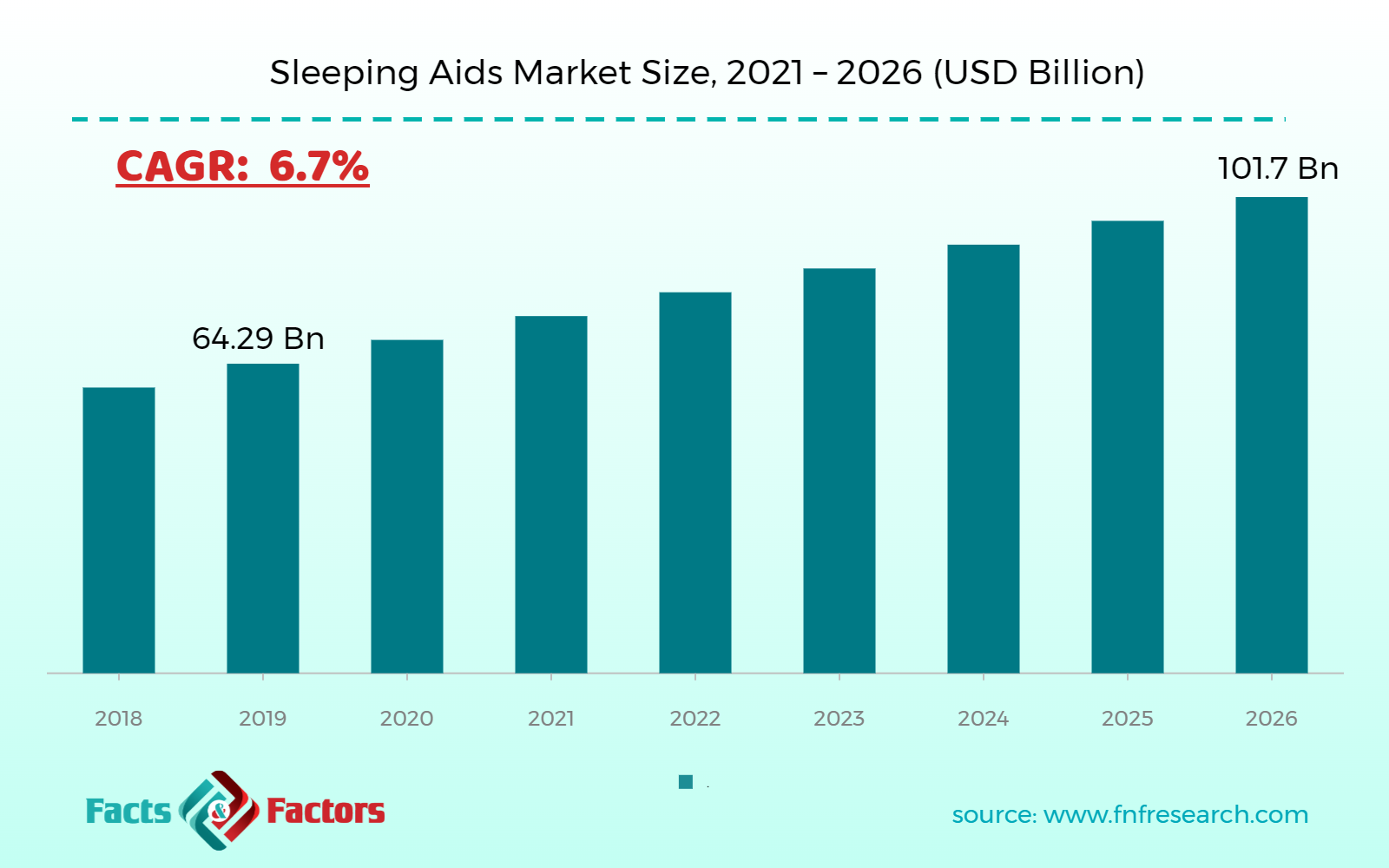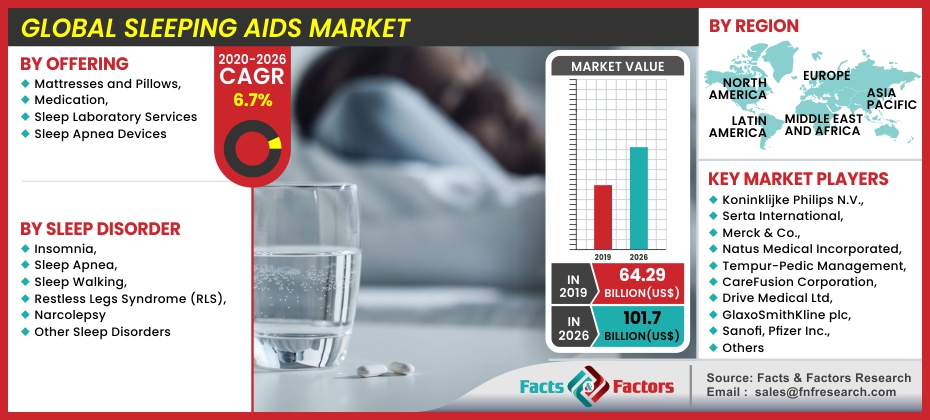Search Market Research Report
Sleeping Aids Market Size, Share Global Analysis Report, ids Market by Offering (Mattresses and Pillows, Medication, Sleep Laboratory Services and Sleep Apnea Devices) and by Sleep Disorder (Insomnia, Sleep Apnea, Sleep Walking, Restless Legs Syndrome (RLS), Narcolepsy and Other Sleep Disorders): Global Industry Perspective, Comprehensive Analysis, and Forecast, 2020 – 2026

Sleeping Aids Market by Offering (Mattresses and Pillows, Medication, Sleep Laboratory Services and Sleep Apnea Devices) and by Sleep Disorder (Insomnia, Sleep Apnea, Sleep Walking, Restless Legs Syndrome (RLS), Narcolepsy and Other Sleep Disorders): Global Industry Perspective, Comprehensive Analysis, and Forecast, 2020 – 2026
Industry Insights
[195+ Pages Report] Global sleeping aids market was projected at USD 64.29 Billion in 2019 and is forecast to hit USD 101.7 Billion in 2026, with CAGR expected to rise by 6.7% between 2020 and 2026.
 Market Overview
Market Overview
Sleep aids are medications or medical devices that help people who have sleep problems fall asleep. Medication, sleep labs, sleep apnea machines, and mattresses and pillows are all examples of sleep aids. During the study, increasing stress levels among people and changing lifestyles in countries such as China and India are projected to major driving factors for the growth of sleeping aid items.

 Industry Growth Factors
Industry Growth Factors
In the coming years, the increasing prevalence of sleep disorders for example obstructive sleep apnea, chronic insomnia, and narcolepsy will drive the global sleep aids industry forward. According to the Centers for Disease Control and Prevention (CDC), some 50 million people in the United States are currently sleep-deprived. In addition, nearly 18 million people suffer from sleep deprivation, which affects their work efficiency. As a result of the increasing prevalence of sleep disorders, demand for preventive and curative medication will rise, propelling the sleeping aids market in the analysis period.

Over the forecast period, increasing disposable income among consumers, combined with increased public knowledge about the negative effects of sleep disorders, would boost the market size for sleep aids. In addition, sleep disturbances can have a detrimental effect on human health and lead to chronic diseases including cardiovascular disease and diabetes.
On the other hand, the negative effects of sleep medications on human health paired with high costs of sleep aids medical procedures could limit market development in near future.
 Global Sleeping Aids Market: Segmentation
Global Sleeping Aids Market: Segmentation
The global Sleeping Aids market can be segmented into offering, sleep disorders, and regions.
Based on the offering, the sleeping aids market is further classified as mattresses and pillows, medication, sleep laboratory services, and sleep apnea devices. Due to its comprehensive features such as usability, enforcement, availability of a variety of items, the mattresses, and pillows category will carry a substantial revenue size over the forecast years. Furthermore, increasing public awareness of the health benefits of good sleep among the growing population would push the sleep aids market in coming years.
In addition, insomnia, sleep apnea, sleepwalking, restless legs syndrome, narcolepsy, and other sleep disorders are the sleep disorder segments bifurcated in the research report.
 Global Sleeping Aids Market: Regional Analysis
Global Sleeping Aids Market: Regional Analysis
Based on regions, we have categorized the global sleeping aids market into five main regions.
Geographically, North America dominated the sleeping aids market, owing to citizens' higher stress levels, increased awareness of such products, and increased spending on healthcare. Europe and Asia-Pacific were the second and third largest markets for sleeping aids, respectively. Due to rapidly growing people living under stress due to changing lifestyles, increased spending, and increased awareness among the population in developing nations such as China and India in this area, Asia Pacific is expected to have the fastest growth in the analysis period.
 Report Scope
Report Scope
Report Attribute |
Details |
Market Size in 2019 |
USD 64.29 Billion |
Projected Market Size in 2026 |
USD 101.7 Billion |
CAGR Growth Rate |
6.7% |
Base Year |
2019 |
Forecast Years |
2020-2026 |
Key Market Players |
Koninklijke Philips N.V., Serta International, Merck & Co., Natus Medical Incorporated, Tempur-Pedic Management, CareFusion Corporation, Drive Medical Ltd, GlaxoSmithKline plc, Sanofi, Pfizer Inc., Takeda Pharmaceutical Company Limited, SleepMed Inc., Compumedics Limited, Teva Pharmaceutical Industries Ltd, Cadwell Laboratories Inc., and eVilbiss Healthcare LLC among others. |
Key Segment |
By Offering , By Sleep Disorder, and By Region |
Major Regions Covered |
North America, Europe, Asia Pacific, Latin America, and the Middle East & Africa |
Purchase Options |
Request customized purchase options to meet your research needs. Explore purchase options |
 Global Sleeping Aids Market: Competitive Players
Global Sleeping Aids Market: Competitive Players
Major players in the Sleeping Aids market are
- DeVilbiss Healthcare LLC.
- SleepMed Inc.
- Pfizer Inc.
- Cadwell Laboratories Inc.
- Merck
- Sanofi
- Pfizer
- SleepMed
- GSK
- Natus Medical Teva Pharmaceutical Industries Ltd.
- Takeda Pharmaceutical Company Limited
- CareFusion Corporation
- Tempur-Pedic Management Inc.
- Serta International
- Drive Medical Ltd.
- Compumedics Limited
 Global Sleeping Aids Market: Regional Segment Analysis
Global Sleeping Aids Market: Regional Segment Analysis
- North America
- U.S.
- Canada
- Europe
- U.K.
- France
- Germany
- The Asia Pacific
- China
- Japan
- India
- Latin America
- Brazil
- Mexico
- The Middle East and Africa
Industry Major Market Players
- DeVilbiss Healthcare LLC.
- SleepMed Inc.
- Pfizer Inc.
- Cadwell Laboratories Inc.
- Merck
- Sanofi
- Pfizer
- SleepMed
- GSK
- Natus Medical Teva Pharmaceutical Industries Ltd.
- Takeda Pharmaceutical Company Limited
- CareFusion Corporation
- Tempur-Pedic Management Inc.
- Serta International
- Drive Medical Ltd.
- Compumedics Limited
Frequently Asked Questions

Copyright © 2024 - 2025, All Rights Reserved, Facts and Factors


